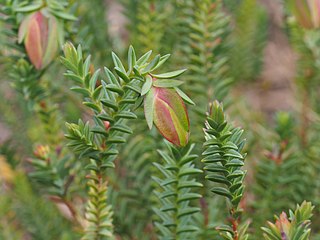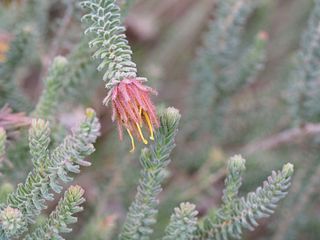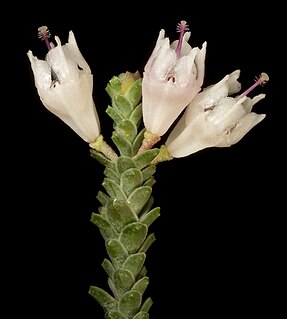
Darwinia, sometimes commonly known as mountain bells or simply bells, is a genus of about 70 species of evergreen shrubs in the family Myrtaceae, endemic to southeastern and southwestern Australia. The majority are native to southern Western Australia, but a few species occur in South Australia, New South Wales and Victoria. The genus was named in honour of Erasmus Darwin, grandfather of Charles Darwin by Edward Rudge in 1816. Most darwinias grow to a height of between 0.2 and 3 m, and many are prostrate shrubs. Most have small, simple leaves and the flowers are often grouped together, each flower with five red, white or greenish petals and ten stamens. In many species, the flowers are surrounded by large, colourful bracts, giving rise to their common names.

Darwinia citriodora, commonly known as lemon-scented darwinia or lemon scented myrtle, is a plant in the myrtle family Myrtaceae and is endemic to the south-west of Western Australia. It is a shrub with oblong to lance-shaped leaves and red, yellow and orange flowers over an extended period. It is a hardy plant in well-drained soil, is often cultivated and used as a rootstock for less hardy species.

Darwinia collina, commonly known as the yellow mountain bell, is a plant in the myrtle family Myrtaceae. It grows as an erect shrub 0.3–1.2 metres (1–4 ft) high with crowded elliptical leaves and bright yellow flower-like inflorescences. It is endemic to a few small areas in the Stirling Range National Park, Western Australia and as a result is classified as an endangered species.

Darwinia apiculata, commonly known as the scarp darwinia, is a plant in the myrtle family Myrtaceae and is endemic to a small area in Western Australia. It is a rounded, densely branched, small shrub with thin red branches and scattered small leaves. The flowers are arranged in small groups on the ends of the branches, their most obvious feature being long, red, pointed bracts surrounding each flower and a longer red style with scattered hairs near its tip.

Darwinia capitellata is a plant in the myrtle family Myrtaceae and is endemic to the south-west of Western Australia. It is a bushy, many-branched shrub, very similar to Darwinia diosmoides but differs in the arrangement of its flowers, its more branched habit, prominent oil glands on the younger stems and its thinner, paper-like bracteoles. It was first discovered as a separate species when specimens of it were found to have a larger chromosome number than specimens of D. diosmoides.

Darwinia carnea, commonly known as Mogumber bell or Narrogin bell is a plant in the myrtle family Myrtaceae and is endemic to the south-west of Western Australia. It is a small shrub with narrow, keeled leaves and flowers in groups of about eight, surrounded by yellowish-green to pinkish-red bracteoles. It occurs in small, isolated populations near the towns which contribute to its common names. It is the only "bell-flowered" Darwinia to not grow in the Stirling Range National Park.

Darwinia chapmaniana, commonly known as Chapman's bell or Eganu bell, is a plant in the myrtle family Myrtaceae, and is endemic to the south-west of Western Australia. It is a low, rounded, spreading shrub with greyish, hairy leaves and flowers in heads of about 14 small, tubular flowers. The heads are surrounded by long, reddish-yellow, hairy bracts.
Darwinia ferricola, commonly known as the Scott River darwinia, is a plant in the myrtle family Myrtaceae and is endemic to a small area in Western Australia. It is a rounded, densely branched shrub with crowded, linear leaves mostly only on younger branches. The flowers are greenish-yellow and red, and arranged in groups on the ends of the branches, with a long white or reddish style protruding from the petal tube.

Darwinia foetida, commonly known as Muchea bell, is a plant in the myrtle family Myrtaceae, and is endemic to Western Australia. It is a small upright shrub with greenish coloured nodding flowers at the apex of the stems, that have an unpleasant odour. This is a very restricted species, known from only a couple of locations.

Darwinia helichrysoides is a plant in the myrtle family Myrtaceae and is endemic to Western Australia.

Darwinia hortiorum is a plant in the myrtle family Myrtaceae and is endemic to Western Australia. It is a compact, densely branched shrub with small leaves and inflorescences composed of up to twenty flowers with glossy, pale yellow to reddish petals and fleshy dark green sepals surrounded by papery brown bracteoles.
Darwinia luehmannii is a plant in the myrtle family Myrtaceae and is endemic to Western Australia.

Darwinia oederoides is a plant in the myrtle family Myrtaceae and is endemic to Western Australia.

Darwinia oldfieldii, commonly known as Oldfield's darwinia, is a plant in the myrtle family Myrtaceae and is endemic to Western Australia.

Darwinia pauciflora is a plant in the myrtle family Myrtaceae and is endemic to Western Australia.

Darwinia pimelioides is a plant in the myrtle family Myrtaceae and is endemic to Western Australia.

Darwinia polychroma, commonly known as the Harlequin bell, is a plant in the myrtle family Myrtaceae and is endemic to Western Australia.

Darwinia sanguinea is a plant in the myrtle family Myrtaceae and is endemic to Western Australia.

Darwinia speciosa is a plant in the myrtle family Myrtaceae and is endemic to Western Australia.

Darwinia vestita, commonly known as the pom-pom darwinia, is a plant in the myrtle family Myrtaceae and is endemic to Western Australia.


















